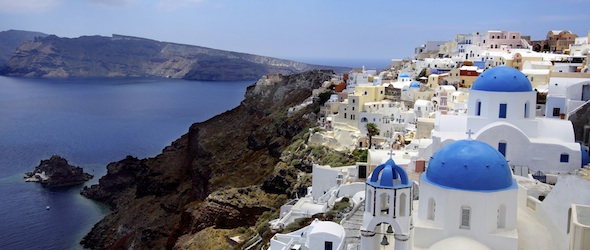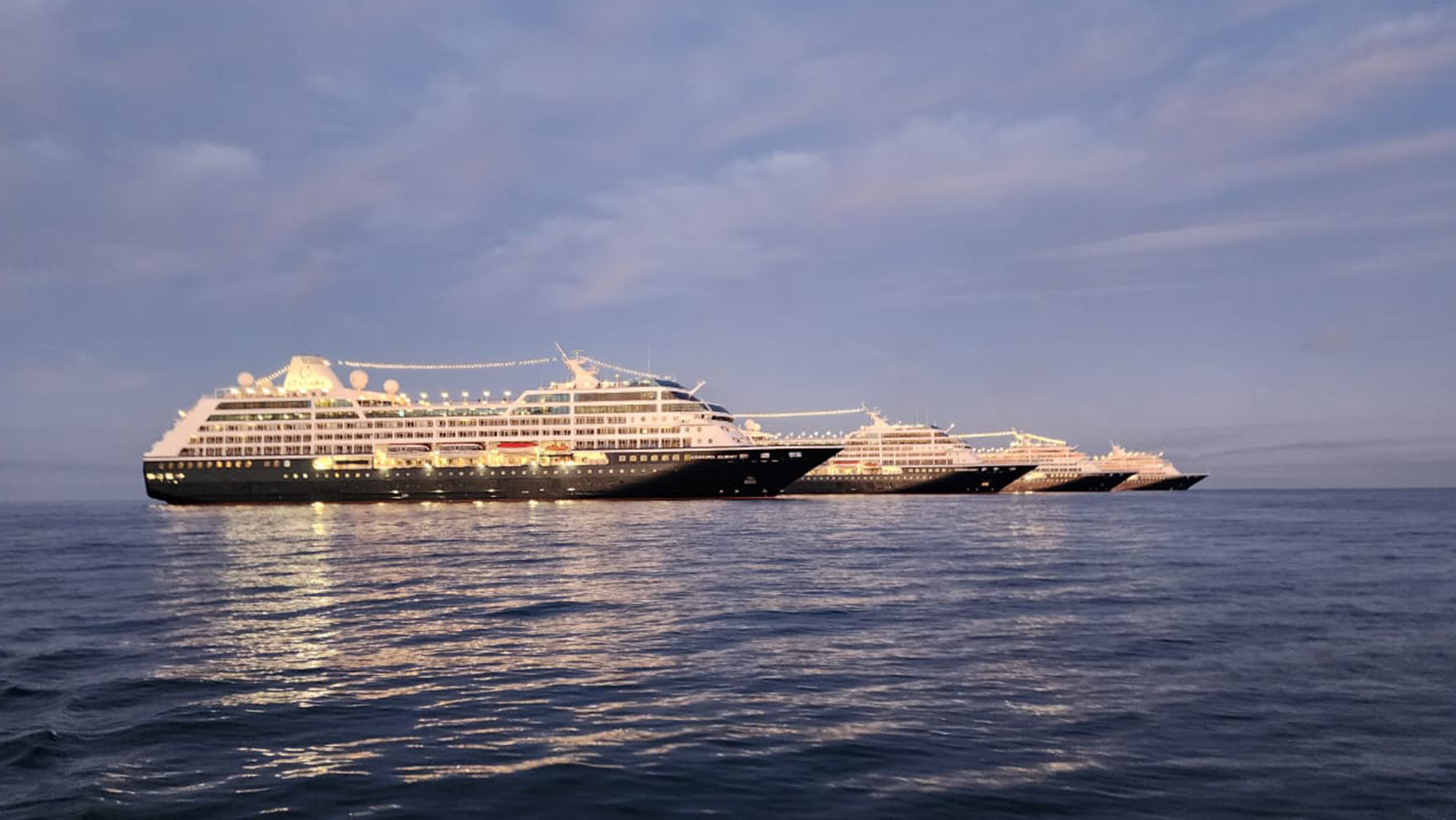A springtime cruise from Athens to Rome aboard the stylish Azamara Journey offers an illuminating snapshot of European history and culture.
“The art of travelling the Mediterranean in style will never be consigned to history.”
So said British ‘national treasure’ and former TV news broadcaster Sir Trevor McDonald when inspecting Christina O, Aristotle Onassis’s original superyacht, for a travel show.
While Azamara Club Cruises’ small to mid-sized Azamara Journey doesn’t sport extreme ‘luxuries’ such as the barstools made of whale foreskin you’ll find on Christina O, she is a tastefully decked-out Renaissance-class ship, and I was taking a classic Mediterranean cruise on her from Athens to Rome.
Azamara Journey is the identical twin sister to Azamara Quest. Both were built in 2000 and refurbished in 2007 in a traditional, ‘country house’ style. Our accommodation in the top-of-the-range Club World Owner’s Suite – an amazingly spacious balcony suite at the aft of the ship on Deck 8 that came with the services of Sooria the butler – was impressive and for about US$3,799 for a seven-night cruise, offers a level of luxury similar to that on five-star ships at considerably lower rates.
Hotel director Scott Daniels told me that Azamara Club Cruises was established in 2007, and that many of the recent changes implemented resulted from passenger feedback. For example, gratuities are now included in the fares, as are wines at lunch and dinner, and soft drinks and coffees all day. In the Suite Class, extras such as access to the spa, a bottle of vodka and scotch, and some free ironing are also included.
On our cruise, there were about 600 guests aboard (maximum passenger capacity is 694) and over the course of the cruise I met several ‘Azamara Club addicts’ who were already booking trips for later in the year. At the end of the 2011 European season, Journey heads west to the Americas and Quest heads east to Asia; in 2012, the twin ships will swap itineraries.
Meanwhile, back in the Med, we departed Piraeus at six o’clock on a Sunday evening after a seamless boarding process and arrived at the volcanic island of Santorini at 8am the next day.
Before breakfast and disembarkation, we took a stretch class at the Fitness Center on Deck 9 – a token effort to make up for the delicious dinner at Prime C, one of two alternative dining restaurants, the night before. It was unseasonably cold on Santorini but the spectacular cable-car ride to the township of Fira, perched on the cliff tops 260 metres above sea level, was enough of a distraction from the weather. If you haven’t been to Santorini before, I would recommend taking a bus or taxi to Oia, a picturesque village at the northern tip of the island. Fira tends to become overrun with tourists, particularly when several cruise ships are anchored in the bay.
A sea day en route to Malta gave us the chance to boost our energy reserves for the feast of historical sites on the itinerary. At Valletta, Malta’s 16th-century capital city, we took one of the ship’s shore excursions, a guided walk that proved enormously informative. This UNESCO World Heritage site boasts ornate Baroque palaces and churches, beautiful gardens and squares bristling with restaurants and cafés. One of the many highlights of our tour was seeing Caravaggio’s painting ‘The Beheading of St John the Baptist’ in St John’s Co-Cathedral; another was the Armoury in the Grand Master’s Palace.
Sicily was our next stop. As the ship anchored early in the morning, we were treated to a spectacular view of Mount Etna’s snow-covered peak towering
over the island.
We took a day-long 4WD trip to the lava fields of the 3,300-metre-high volcano with a couple of American passengers from the ship who’d booked the trip online, and for half the price of the ship’s tour (which had been cancelled for a lack of takers), we enjoyed a fascinating, educational day.
Francesco was a superb guide, pointing out evidence of the country’s Greek, Roman, Norman, French and Spanish heritage. At the foot of Mount Etna, the landscape is lush, green and fertile – tropical plants grow in profusion alongside chestnut bushes and cherry trees and, higher up the slopes, you see vines, olive groves and citrus trees.
As we neared the peak, thick clouds shrouded the dramatic craters and lunar-like landscape, and silver birch trees loomed ghostlike through the mist. We walked along the edge of a crater, crunching over ash and cinders, clambered into a lava cave and photographed the shortest road in Europe: one cut short by a massive, recent lava flow.
On the way back to the port, we wandered through the beautiful medieval town of Castiglione. Our last stop was a visit to the Gole d’Alcàntara, a spectacular ravine where you can see more effects of Mount Etna’s eruptions, in the form of columns of lava through which the river Càntara flows.
A return visit to Sicily is definitely on my ‘to do’ list; however, we had two full days in the picturesque cliff-top town of Sorrento to explore more of Italy’s classic attractions.
We took a crowded bus trip along the scenic Amalfi Coast to the former fishing village of Positano. The town featured in the movies Under the Tuscan Sun and The Talented Mr Ripley and, while its winding steps, tiny alleyways, flower-filled café windows and cute restaurants are exceptionally photogenic, it is chock-a-block with tourists – virtually impossible to get shots that don’t feature somebody’s back/head/hat.
We strolled down to the black-sand beach for lemon granita at a restaurant and decided to head for Capri by boat. A 50-minute, €50 ($68) ride on a powerful rubber ducky on thankfully calm water took us past dramatic cliffs and three tiny islands to Capri’s Marina Grande. Here, we boarded the funicular railway to La Piazzetta. This is the island’s main square and, like Positano’s, it was thronged with tourists, so we hopped on a local bus to Anacapri, where we took the chairlift to the top of the mountain – a scary but visually rewarding experience.
A quick hydrofoil ride for €17 ($23)returned us to Sorrento and our ‘home away from home’, where we treated ourselves to an excellent dinner in Aqualina, the ship’s other alternative dining restaurant. The menu is ‘American Mediterranean’ and, as at Prime C, there is a $15 surcharge (although not if you’re in a suite). Both are well worth visiting (I preferred the food at Prime C) but do remember to book.
While we couldn’t do everything in one short cruise, a visit to Pompeii, arguably the most famous archaeological site in the world, was essential. A 30-minute train ride took us virtually to the entrance and, having had local guides at Valletta and Mount Etna, we knew we’d benefit from the services of an official guide here. After paying the entrance fee (€11/$15), we were lucky enough to find the wonderfully informative and entertaining guide Mario Visconti (€10/$13).
I took notes and photos, and had a map and a guidebook, but nothing can beat being there – and a feature this short can’t do any justice to the centuries of history encapsulated in these 66-odd hectares of grand villas, shops, restaurants, temples, public baths, marketplaces and amphitheatre. Now I’m back on land, I’m looking forward to reading Robert Harris’s novel Pompeii to continue my history education in an easily digestible format.
On the train back to Sorrento, I overheard a woman saying that the nearby site of Herculaneum, also destroyed and preserved in the eruption of 79AD, was “much better” than Pompeii – yet another destination I have to add to That List.
This was the final destination. We disembarked at Civitavecchia, the port of Rome, which is several kilometres from the city – and two days in the Eternal City proved a fitting finale to our history-packed Azamara Journey cruise.
HIGHS
Friendly ambience; superb service and dining; long stays in port; the magnificent Drawing Room (library).
LOWS
Overload of chlorine in thalassotherapy pool; small swimming pool; cluttered daily activities sheet.
FACT FILE
Cruise Line: Azamara Club Cruises
Vessel: Azamara Journey
Star rating: 4
Max. passenger capacity: 694
Total crew: 408
Passenger decks: 9
GRT: 30,277 tons
Entered service: Feb 2000/May 2007
Facilities: 347 staterooms including 49 suites, 199 with private balcony, 6 wheelchair-accessible; 6 restaurants (Discoveries, Windows Café, Mosaic Café, Pool Grill, Prime C, Aqualina); 9 bars and cafés; 1 pool; 2 whirlpools; day spa and gym; jogging/walking track; library; internet café; wi-fi; self-service laundry.
BOOKINGS: www.azamaraclubcruises.com or call 1800 754 500 for more information.









Glad you made it home safely! Not sure if you heard, but a man fell over board on one of those ciruses in the Caribean . . .I was like OMG, not BosGuy!!